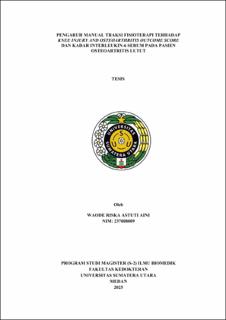| dc.description.abstract | Background: Knee osteoarthritis (OA) is the most common degenerative joint disease with a high prevalence worldwide. Knee OA causes pain, joint stiffness, muscle weakness, and decreased functional activity, significantly impacting patients' quality of life. Inflammatory factors, particularly interleukin-6 (IL-6), play a role in the pathogenesis of knee OA by contributing to inflammation and pain sensitization. The management of knee OA includes both pharmacological and non-pharmacological therapies, with manual traction therapy being one of the physiotherapy modalities that can reduce pain and improve joint function. However, the relationship between manual traction, the reduction of IL-6 levels, and the improvement of the Knee Injury and Osteoarthritis Outcome Score (KOOS) remains underexplored.
Objective: This study aimed to investigate the effects of manual traction physiotherapy on KOOS outcomes and serum IL-6 levels in individuals with knee osteoarthritis.
Methods: A pre-post experimental study was conducted involving 36 patients diagnosed with knee OA who met the inclusion criteria. Participants received manual traction physiotherapy twice weekly over a four-week period. Serum IL-6 levels were measured via blood tests, and knee joint functionality was evaluated using the KOOS instrument, both prior to and following the intervention. The Wilcoxon Signed Rank Test was employed to assess changes in KOOS scores and IL-6 concentrations pre- and post-intervention. Additionally, Spearman's correlation analysis was conducted to examine the association between changes in IL-6 levels and KOOS scores.
Results: Statistical analysis revealed a significant improvement in KOOS scores following the intervention (p = 0.001), indicating enhanced knee joint function. However, no significant change was observed in IL-6 levels post-intervention (p = 0.491). Furthermore, Spearman's correlation indicated no significant relationship between alterations in IL-6 levels and KOOS scores (p = 0.760).
Conclusion: Manual traction physiotherapy significantly improves functional outcomes and quality of life in patients with knee osteoarthritis, as evidenced by increased KOOS scores. Nevertheless, the therapy does not significantly affect systemic IL-6 levels, and improvements in joint function appear to be predominantly driven by mechanical rather than inflammatory factors | en_US |


